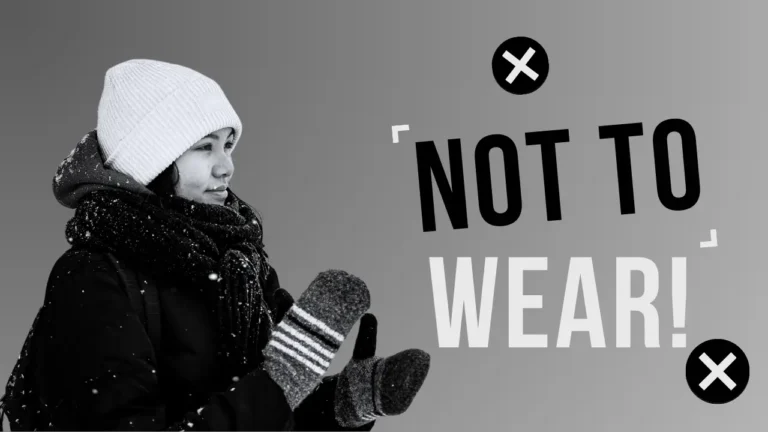You should avoid wearing overly casual, revealing, or flashy clothing in Spain, especially in more conservative areas or religious sites. Spain values style and modesty, so it’s important to dress appropriately. Avoid items like beachwear, flip-flops, or tank tops when not at the beach, as well as overly bold or flashy outfits that may draw unwanted attention. Opt for smart-casual attire that is both comfortable and respectful, ensuring you blend in and show respect for local customs and traditions.
What Men Should Not Wear in Spain?
Men should avoid wearing the following in Spain:
- Flip-Flops and Beachwear: Unless you’re at the beach or poolside, wearing flip-flops and overly casual beach attire in cities or restaurants is inappropriate. Spain favors more stylish footwear and smart-casual outfits.
- Tank Tops and Sleeveless Shirts: These are not suitable for walking around cities or visiting religious sites, as they can be seen as too casual and disrespectful, particularly in more traditional areas.
- Loud or Flashy Outfits: Bright colors, bold prints, or excessive accessories may come off as out of place. Spain’s fashion culture values elegance and simplicity, so it’s best to keep clothing understated.
- Sports Jerseys Outside of Sporting Events: Wearing sports jerseys casually, outside of a game or sports-related event, may be considered too informal in most public spaces.
- Shorts in the Evening: While acceptable during the day in hotter regions, shorts in the evening, especially in cities or at restaurants, can be considered too casual. Opt for light trousers or chinos for a more polished look.
- Athletic Wear in Public: Wearing gym clothes or athletic wear outside of exercise settings is generally not embraced in Spain, especially in restaurants, bars, or social gatherings.
What Women Should Not Wear in Spain?
Women should avoid wearing the following in Spain:
- Beachwear Away from the Beach – Wearing bikinis, swimsuits, or beach cover-ups in city streets, restaurants, or shops is generally frowned upon. It’s best to reserve beachwear for the beach or poolside.
- Revealing Clothing – Spain is stylish but conservative, especially in religious sites or smaller towns. Avoid overly revealing clothing such as very short skirts, low-cut tops, or sheer outfits.
- High Heels on Cobblestone Streets – While fashionable, high heels can be impractical and even dangerous on Spain’s cobblestone streets. Opt for stylish yet comfortable flats or sandals when walking around.
- Loud or Flashy Outfits – Bright, bold patterns and excessive accessories may stand out in a way that isn’t always welcomed. Spain’s fashion scene leans toward elegance and subtlety, so it’s better to choose more understated clothing.
- Sportswear Outside of the Gym – Wearing gym clothes or athletic wear in non-exercise settings is not commonly accepted in Spain, especially in restaurants, bars, or cultural sites. Save sportswear for workouts and opt for casual-chic attire for other activities.
- Shorts in the Evening – While shorts are fine during the day in hot weather, they are often considered too casual for evening wear, especially in cities or when dining out. Consider light dresses or trousers for a more appropriate evening look.
What Not To Wear in Spain in January?
You should avoid wearing overly light or summer clothing in Spain in January, as the weather can be quite cool, especially in the mornings and evenings. Lightweight fabrics like linen, shorts, and sleeveless tops are not suitable for the winter chill.
Additionally, open-toed shoes or sandals should be avoided as they won’t keep your feet warm. Flashy, bright-colored clothing is also best left at home, as it can be out of place during this quieter, more subdued time of year. Instead, opt for warmer layers, closed-toe shoes, and muted tones that align with the season’s mood.
What Not To Wear in Spain in February?
You should avoid wearing light, summer clothing in Spain in February, as it’s still winter, and temperatures can be quite cool, especially in the mornings and evenings. Avoid items like shorts, sleeveless tops, and thin fabrics, as they won’t provide enough warmth.
Open-toed shoes or sandals are also not appropriate for the chilly weather. Additionally, overly bright or flashy clothing may feel out of place during this time of year, when more muted tones and layers are preferred. Stick to warm, comfortable clothing that keeps you cozy and blends with the winter atmosphere.
What Not To Wear in Spain in March?
You should avoid wearing overly light or summery clothing in Spain in March, as the weather can still be cool, especially in the early mornings and evenings. Items like shorts, sleeveless tops, and thin fabrics may not be sufficient for the varying temperatures. Open-toed shoes or sandals are not ideal, as they won’t provide enough warmth for the cooler days.
Additionally, bright or flashy clothing might feel out of place during this transitional season. It’s better to opt for layered clothing in more subdued tones that can easily be adjusted to the changing weather throughout the day.
What Not To Wear in Spain in April?
You should avoid wearing overly heavy winter clothing in Spain in April, as the weather begins to warm up, but can still be unpredictable. Thick coats, woolen scarves, and heavy boots may be too warm for the mild spring days. At the same time, avoid summer attire like shorts, tank tops, and flip-flops, as the temperatures can still be cool, especially in the mornings and evenings.
Bright, flashy colors might also be less appropriate, as spring in Spain is often celebrated with more subdued, elegant tones. Instead, opt for lighter layers that can be easily adjusted to the changing weather.
What Not To Wear in Spain in May?
You should avoid wearing heavy winter attire in Spain in May, as the weather is generally warm and pleasant. Thick coats, heavy boots, and woolen accessories are unnecessary and may leave you feeling overheated.
What Not To Wear in Spain in June?
You should avoid wearing overly heavy or warm clothing in Spain in June, as the weather is typically hot and sunny. Thick jackets, woolen garments, and heavy boots are far too warm for the summer temperatures.
Additionally, it’s best to avoid wearing overly casual items like beachwear or flip-flops in cities or more formal settings, as they can appear too relaxed. Bright, flashy outfits might also feel out of place in certain cultural sites or upscale areas. Instead, opt for light, breathable clothing that keeps you cool while still being appropriate for various occasions.
What Not To Wear in Spain in July?
You should avoid wearing heavy or overly warm clothing in Spain in July, as the weather is typically very hot and sunny. Thick jackets, sweaters, and heavy boots will be uncomfortable in the intense summer heat.
It’s also wise to avoid overly casual items like beachwear, tank tops, and flip-flops in urban areas or formal settings, as they can be seen as too informal. Flashy, bright outfits may not be suitable for certain cultural sites or upscale venues. Instead, choose light, breathable fabrics that keep you cool while still being respectful of the local culture and setting.
What Not To Wear in Spain in September?
You should avoid wearing heavy winter clothing in Spain in September, as the weather is generally warm and mild, especially during the early part of the month. Thick coats, heavy boots, and woolen scarves are unnecessary and can leave you feeling overheated.
At the same time, overly casual beachwear like flip-flops, swimsuits, or shorts may not be suitable outside of coastal areas. Bright, flashy colors might also be less appropriate in certain settings, particularly in more conservative or formal environments. Opt for light layers that can adapt to the slightly cooler evenings while still keeping you comfortable during the warmer daytime hours.
What Not To Wear in Spain in October?
You should avoid wearing overly summery clothing in Spain in October, as the weather begins to cool down, especially in the evenings. Items like shorts, tank tops, and flip-flops may no longer be suitable for the changing season. On the other hand, heavy winter clothing, such as thick coats and woolen accessories, might be too warm for the mild daytime temperatures.
Additionally, bright and flashy outfits may feel out of place, particularly in more traditional or formal settings. Instead, opt for versatile layers that can be adjusted to the cooler mornings and evenings while remaining comfortable during the warmer parts of the day.
What Not To Wear in Spain in November?
You should avoid wearing lightweight summer clothing in Spain in November, as the weather is typically cooler and more unpredictable. Shorts, tank tops, and sandals will not provide enough warmth for the chilly mornings and evenings. However, heavy winter gear like thick coats and boots might still be too much for the milder daytime temperatures.
Bright, flashy outfits may also seem out of place, particularly in more conservative or formal environments. Instead, opt for warm layers that can be easily added or removed throughout the day, and choose neutral or muted tones that align with the season’s mood.
What Not To Wear in Spain in December?
You should avoid wearing overly light or summery clothing in Spain in December, as the weather is generally cool and can be quite cold, especially in the mornings and evenings. Items like shorts, tank tops, and sandals will leave you feeling underdressed for the winter season.
While heavy, Arctic-style winter gear might be unnecessary, you should also steer clear of overly casual attire like flip-flops or beachwear unless you’re in a very warm coastal area. Flashy or bright colors might feel out of place in more traditional settings, so it’s best to stick to muted, seasonal tones and opt for warm layers, such as sweaters and medium-weight coats, that keep you comfortable throughout the day.
FAQs On What Not To Wear in Spain
Flip-flops are generally only appropriate for the beach or pool. In cities and more formal settings, they are considered too casual and can be uncomfortable for walking long distances.
Bright and flashy clothing can sometimes be seen as too bold or out of place, particularly in more conservative or traditional areas. It’s usually better to opt for more subdued tones that blend in with Spain’s stylish yet understated fashion sense.
Heavy winter clothing is usually not needed, except in certain mountainous regions during the coldest months. In most of Spain, layering with medium-weight coats and sweaters is sufficient to stay warm in the winter.




